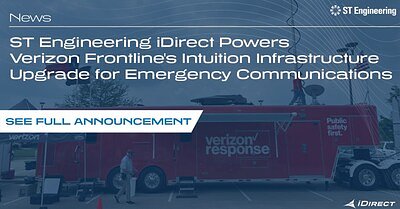
Verizon Boosts Emergency Response with Cloud-Native Satellite Upgrade
Verizon Frontline is modernizing its disaster response network with ST Engineering iDirect’s cloud-native satellite infrastructure, promising faster deployment, increased resilience, and enhanced connectivity during critical events.
Verizon Boosts Emergency Response with Cloud-Native Satellite Upgrade
Reston, VA – November 03, 2025 – Verizon Frontline is significantly upgrading its emergency communications infrastructure with a new cloud-native satellite solution from ST Engineering iDirect. The modernization, announced earlier this week, aims to bolster the company’s ability to provide reliable connectivity for first responders and affected communities during natural disasters and other critical events.
This isn't just a hardware refresh. The upgrade represents a strategic shift towards a more agile, resilient, and scalable network architecture, leveraging the power of virtualization and cloud computing. By adopting ST Engineering iDirect’s Intuition platform and deploying its innovative DCR/DBR (Digital Communications Relay/Dynamic Bandwidth Routing) hub, Verizon aims to drastically reduce its physical footprint at teleport facilities, while simultaneously enhancing its capacity to deploy resources quickly and maintain uninterrupted service.
A Paradigm Shift in Satellite Communications
The timing of this announcement aligns with a broader transformation occurring within the satellite communications industry. Historically, satellite networks relied on dedicated hardware and complex infrastructure, making them expensive to deploy and maintain. However, the emergence of cloud-native technologies is disrupting this traditional model, offering greater flexibility, scalability, and cost-efficiency.
“The industry is moving towards a software-defined future,” explained one industry analyst who wished to remain anonymous. “Cloud-native architectures allow operators to manage their networks remotely, dynamically allocate bandwidth, and respond rapidly to changing demands. This is particularly crucial in the context of disaster response, where speed and agility are paramount.”
The DCR/DBR hub, a key component of the upgrade, is designed to reduce the physical space required for satellite ground infrastructure. This allows Verizon to deploy resources faster and more efficiently, even in challenging environments where traditional infrastructure is unavailable or damaged. “Reducing the footprint is huge,” a source familiar with the project stated. “It’s about being able to get up and running quickly, anywhere.”
Addressing the Growing Threat of Climate Change
The need for a more resilient emergency communications infrastructure has become increasingly urgent in recent years, as the frequency and severity of natural disasters continue to rise due to climate change. Hurricanes, wildfires, floods, and other extreme weather events often disrupt terrestrial communication networks, leaving communities isolated and hindering rescue efforts.
“When terrestrial infrastructure fails, satellite is often the only lifeline,” a first responder commented anonymously. “Having a reliable and resilient satellite network is essential for coordinating response efforts, communicating with affected communities, and saving lives.”
The upgrade to a cloud-native architecture will enable Verizon Frontline to bridge connectivity gaps and maintain uninterrupted service, even when terrestrial networks are down. The multi-orbit capabilities of the Intuition platform will allow the company to leverage a variety of satellite constellations, including geostationary (GEO), medium Earth orbit (MEO), and low Earth orbit (LEO) satellites, providing greater redundancy and capacity.
Competition and the Future of VSAT
The VSAT (Very Small Aperture Terminal) market is highly competitive, with major players like Viasat, Hughes Network Systems, and Intelsat vying for market share. However, the emergence of LEO constellations, such as those operated by SpaceX’s Starlink and Amazon’s Project Kuiper, is disrupting the traditional landscape.
“The LEO constellations are forcing incumbents to innovate and adapt,” explained another analyst. “They are driving down prices and increasing bandwidth availability, but they also require new ground infrastructure that can handle the complexities of multi-orbit connectivity.”
ST Engineering iDirect appears to be positioning itself as a key enabler for this transition, offering solutions that can seamlessly integrate and manage connectivity across multiple orbits. The company’s partnership with Viasat, announced in October, demonstrates its commitment to supporting the next generation of satellite networks.
Financial Implications and Long-Term Benefits
While the exact cost of the upgrade has not been disclosed, industry analysts believe that the investment will yield significant long-term benefits for Verizon Frontline. The reduction in physical infrastructure will lead to lower operating costs, while the increased agility and scalability of the network will enable the company to respond more effectively to changing demands.
“Cloud-native architectures are not just about cost savings; they’re about unlocking new business opportunities,” explained an industry consultant. “By modernizing its infrastructure, Verizon is positioning itself to provide innovative services and capture a larger share of the rapidly growing emergency communications market.”
The upgrade is also expected to enhance Verizon’s reputation as a reliable and resilient service provider, strengthening its relationships with government agencies, public safety organizations, and enterprise customers.
A Resilient Future for Emergency Communications
The partnership between Verizon Frontline and ST Engineering iDirect signifies a crucial step towards building a more resilient and responsive emergency communications infrastructure. As the threat of natural disasters continues to grow, investments in innovative technologies like cloud-native satellite networks will be essential for protecting communities and saving lives.
“This isn’t just about technology; it’s about ensuring that first responders have the tools they need to do their jobs effectively,” concluded the first responder. “Reliable communication is the lifeline of any emergency response effort.”
The upgrade is expected to be completed in phases over the next several months, with the initial deployments focused on areas that are particularly vulnerable to natural disasters.
